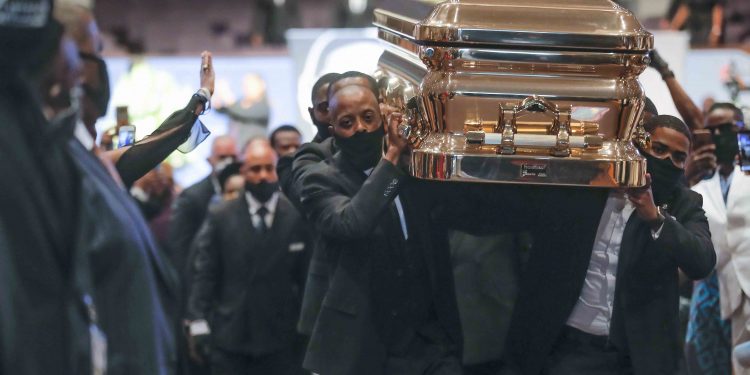Minneapolis (US): The video of George Floyd gasping for breath was shown as ‘Exhibit A’ as the former Minneapolis police officer who pressed his knee on the Black man’s neck went on trial Monday. The police officer is facing charges of murder and manslaughter.
Prosecutor Jerry Blackwell showed the jurors the footage at the earliest opportunity, during opening statements. Blackwell told them that the number to remember was nine minutes, 29 seconds. It is the exact time frame officer Derek Chauvin had George Floyd pinned to the pavement last May.
The white officer ‘didn’t let up’ even after a handcuffed Floyd said 27 times that he couldn’t breathe and went limp. Floyd’s case triggered worldwide protests, scattered violence and national soul-searching over racial justice.
“He (Chauvin) put his knees upon his neck and his (Floyd) back, grinding and crushing him, until the very breath – no, ladies and gentlemen – until the very life was squeezed out of him,” the prosecutor said. Chauvin attorney Eric Nelson countered the argument. “Derek Chauvin did exactly what he had been trained to do over his 19-year career,” Nelson said.
Also read: George Floyd murder suspect, Derek Chauvin, released from jail on $1m bail
Floyd was resisting arrest, and Chauvin arrived to assist other officers who were struggling to get Floyd into a squad. The crowd around them meanwhile grew larger and more hostile, Nelson said. The defense attorney also disputed that Chauvin was to blame for Floyd’s death. Floyd, 46, had none of the telltale signs of asphyxiation and had fentanyl and methamphetamine in his system, Nelson said.
“There is no political or social cause in this courtroom,” Nelson said. “But the evidence is far greater than 9 minutes and 29 seconds,” he added.
The medical examiner’s autopsy noted fentanyl and methamphetamine in Floyd’s system. However, it listed his cause of death as ‘cardiopulmonary arrest, complicating law enforcement subdual, restraint, and neck compression’.
Chauvin, 45, is charged with unintentional second-degree murder, third-degree murder and manslaughter. The most serious charge, the second-degree murder count, carries up to 40 years in prison. The case is the first trial ever televised in Minnesota.
The first witness was Minneapolis police dispatcher Jena Scurry. She testified that she saw part of Floyd’s arrest unfolding via a city surveillance camera. She said she was so disturbed that she called a duty sergeant.
Scurry said she grew concerned because the officers hadn’t moved after several minutes. “You can call me a snitch if you want to,” Scurry said in her call to the sergeant, which was played in court. She said she wouldn’t normally call the sergeant about the use of force because it was beyond the scope of her duties. However, ‘my instincts were telling me that something is wrong’.
The video played during opening statements was posted to Facebook by a bystander. The person witnessed Floyd being arrested after he was accused of trying to pass a counterfeit USD 20 bill at a convenience store. The footage caused revulsion across the US. And beyond also.
Jurors watched intently as the video played on multiple screens. One drew a sharp breath as Floyd said he couldn’t breathe.
Chauvin sat calmly during opening statements and took notes, looking up at the video periodically. “My stomach hurts. My neck hurts. Everything hurts,” Floyd says, and: “I can’t breathe, officer.”
Fourteen people in the jury box are hearing the case — eight of them white, six of them Black or multiracial, according to the court.







































